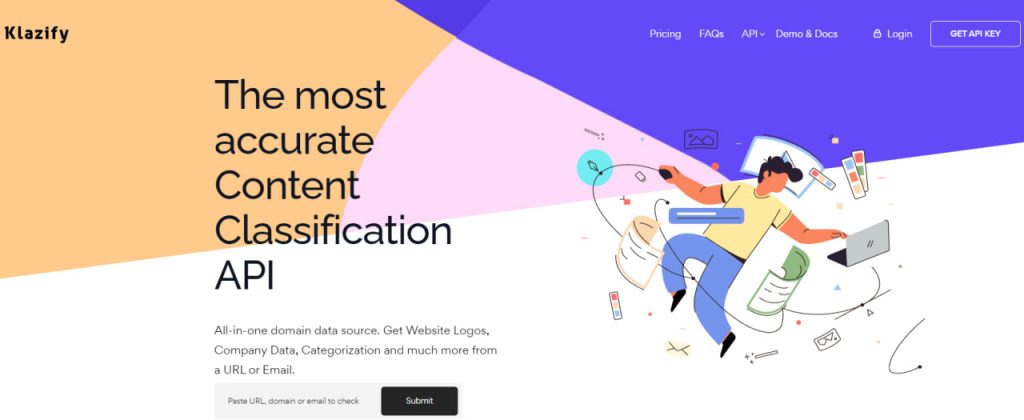In today’s data-driven world, extracting meaningful insights from vast amounts of unstructured content is a significant challenge. Businesses across various industries require efficient methods to classify and analyze content to uncover valuable information and drive informed decision-making. Content classification, the process of categorizing text and multimedia content into predefined categories, plays a crucial role in achieving this goal. With the advent of powerful Application Programming Interfaces (APIs), content classification has become more accessible, scalable, and efficient than ever before. In this article, we will explore the potential of content classification with APIs and the impact it can have on businesses.
Content classification involves the categorization of diverse types of content, such as documents, articles, images, videos, and social media posts, into predefined classes or categories. This process enables businesses to organize, search, and analyze large volumes of data, leading to valuable insights and actionable intelligence. By applying machine learning algorithms and natural language processing techniques, content classification APIs can automatically analyze and assign appropriate categories to content based on its context, keywords, or visual features.
Introducing Klazify, An All In One API
As content classification continues to grow as a trend, businesses need to be able to tap into this field with the best tools possible to reap the most rewards. This is why we recommend Klazify, a versatile and powerful API that any business can profit from.

By utilizing a content classification API like Klazify, businesses can efficiently analyze web pages and extract specific data points, providing valuable insights into their online performance and competitive landscape. Irrespective of a company’s size, an API capable of web scraping can prove to be a tremendous asset.
One of the primary advantages of employing a content classification API is its ability to significantly enhance the accuracy of data collection endeavors. With Klazify‘s exceptional capability to categorize and filter out irrelevant information, the collected data becomes highly relevant and of superior quality. This, in turn, empowers businesses to make well-informed decisions, optimize their operational processes, and gain a competitive advantage within their industry.
Furthermore, utilizing Klazify offers the advantage of saving substantial time and resources. Instead of manually sifting through extensive data pages, the API automates the filtering and extraction of the desired information, reducing the time and effort required for data collection. Consequently, this frees up valuable time for the team to concentrate on more critical tasks such as analyzing and interpreting the collected data.
How Does This API Work?
Klazify is at its core a content classification API, and it has several dedicated endpoints to perform accurate queries on several fields. The API is tailored to provide a plethora of data about any company with an online presence.
Here’s an example of the resulting endpoint after retrieving a company’s data with the API, all it takes is the company’s URL as input for it to perform the search. In this case, the target of the query was the site of the video telephony software Zoom:
{
"domain": {
"categories": [
{
"confidence": 0.86,
"name": "/Computers & Electronics/Software/Business & Productivity Software"
},
{
"confidence": 0.85,
"name": "/Internet & Telecom"
},
{
"confidence": 0.82,
"name": "/Computers & Electronics/Enterprise Technology"
},
{
"confidence": 0.76,
"name": "/Business & Industrial"
}
],
"social_media": {
"facebook_url": "http://www.facebook.com/zoomvideocommunications",
"twitter_url": "http://www.twitter.com/zoom_us",
"instagram_url": null,
"medium_url": null,
"youtube_url": "http://www.youtube.com/zoommeetings",
"pinterest_url": null,
"linkedin_url": "http://www.linkedin.com/company/2532259",
"github_url": null
},
"logo_url": "https://klazify.s3.amazonaws.com/10108745391611736344601125186950f4.51964721.png"
},
"success": true,
"objects": {
"company": {
"name": "Zoom Video Communications",
"city": "San Jose",
"stateCode": "CA",
"countryCode": "US",
"employeesRange": "1K-5K",
"revenue": null,
"raised": 145500000,
"tags": [
"Information Technology & Services",
"Technology",
"Telecommunications",
"B2B",
"SAAS",
"Enterprise"
],
"tech": [
"google_apps",
"pardot",
"aws_route_53",
"mailchimp",
"youtube",
"google_analytics",
"mandrill",
"amazon_ses",
"google_tag_manager",
"salesforce",
"recaptcha",
"workday",
"apache_apex",
"sage_50cloud",
"quickbooks",
"oracle_data_integrator",
"db2",
"apache_tomcat",
"atlassian_jira",
"bluekai",
"rubicon_project",
"microsoft_dynamics",
"gotomeeting",
"filemaker_pro",
"appnexus",
"netsuite",
"teradata",
"microsoft_project",
"aws_redshift",
"hbase",
"informatica",
"aws_lambda",
"paychex",
"aws_dynamodb",
"apache_http_server",
"github",
"hootsuite",
"qlikview",
"ibm_cognos",
"pentaho",
"google_search_appliance",
"sap_concur",
"neo4j",
"apache_maven",
"sap_crm",
"netsuite_crm",
"apache_cassandra",
"openx",
"dc_storm",
"apache_spark",
"sap_business_objects",
"iponweb_bidswitch",
"oracle_peoplesoft",
"mongodb",
"windows_server",
"cision",
"pagerduty",
"oracle_weblogic",
"facebook_workplace",
"oracle_essbase",
"okta",
"dstillery",
"pubmatic",
"turn",
"sap_crystal_reports",
"soasta",
"hive",
"sugarcrm",
"oracle_crm",
"microstrategy",
"apache_hadoop",
"oracle_hyperion",
"peoplesoft_crm",
"postgresql",
"cloudera",
"snaplogic",
"aws_iam",
"mysql",
"dropbox"
]
}
},
"domain_registration_data": {
"domain_age_date": "2002-04-24",
"domain_age_days_ago": "7482",
"domain_expiration_date": "2025-04-23",
"domain_expiration_days_left": "917"
},
"similar_domains": [
"notion.so",
"google.com",
"calendly.com",
"figma.com",
"linkedin.com",
"facebook.com",
"instagram.com",
"twitter.com",
"airtable.com",
"github.com"
]
}How Can I Get This API?
Content classification APIs, with Klazify at the forefront, have revolutionized the way businesses analyze and extract value from vast amounts of data. The ability to categorize and understand content at scale opens up opportunities for improved decision-making, increased efficiency, and enhanced customer experiences. As APIs continue to evolve and leverage advanced machine learning techniques, the potential of content classification will only grow, offering businesses new avenues to gain insights, automate processes, and stay competitive in an increasingly data-centric world. Embracing Klazify can unlock the power of data and drive success across various industries. You can try it out by following these instructions:

- Create an account at Klazify’s site. Then select your desired endpoint of choice.
- Use these codes and then call the API. You can get a unique API key on your account dashboard.
- Finally, press the “Run” button and you’re ready! The API response will be on your screen. You can also choose a programming language.

